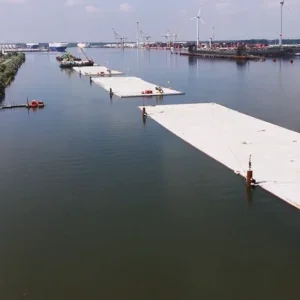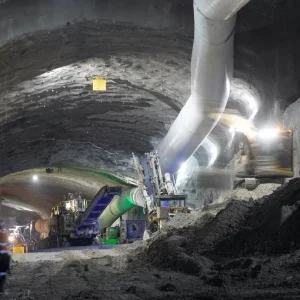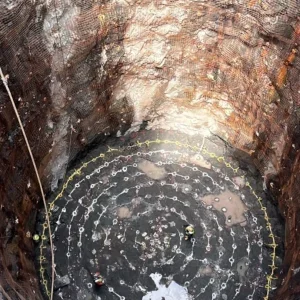Polish commuters are doubtless hoping the construction of the second metro line in the capital Warsaw is completed significantly faster than the first. Work on that lasted several decades, interrupted by the Second World War’s Warsaw Uprising, Nazi blitzing and Soviet shelling, and then post-war financing shortfalls. Once fully underway in the 1980s it was held up and delayed by political upheavals too.
Technically, the new line should also be built much faster. With four modern TBMs to make the main drives rather than the basic cut and cover techniques used on the first project, the 7km long central underground tunnel excavation could be finished in 2013, with the line ready by 2014. Seven stations, and six other ventilation and power substation structures, will also be much quicker since they are using modern diaphragm wall boxed excavations.
Past and present
However, there may yet be some impact of the past on the project because the ground in Warsaw still contains numerous pieces of ordnance and unexploded bombs dating all the way back to the heavy fighting of 1939 and 1945. So far some 600 items have been encountered says Francesco Scaglione, contract manager and east Europe director for Italian contractor Astaldi, which has a lead role in the three firm consortium building the project. "Each requires stopping work and calling in the police and army bomb disposal squads," he says, "though that seems to happen quite quickly here."
The Italian contractor is part of AGP Metro Polska, a three way grouping along with Turkish firm Guermak Agir Sanayi Insaat and local firm Przedsiebiorstwo Budowy Drog I Mostow Minsk Mazowiecki which won the project in late 2009 for PLN 4.1bn (USD 1.2bn). The work is a four-year long package, a design/build contract for the new line’s initial central section of some 7km and seven stations. Conceptual design and alignment for the bid was undertaken by a joint venture of BP Metroprojekt and AMC Choldzynski.
Another three stations will be added at either end once work is complete and design work for these was let in December last year.
"The complete second metro line will have nineteen stations eventually," says Mateusz Witczynski, a spokesman for the consortium, "extending as far as the Mor district on the western side and Brodno on the east." Total project cost is USD 1.9bn.
The current middle underground section runs through the centre of the city just south of its famous old town, the historic medieval city centre of Warsaw which was almost completely destroyed by deliberate demolition when Hitler’s occupying troops retreated. Its streets, churches and state buildings were accurately rebuilt in subsequent decades. Further west the route passes another landmark structure, the giant Stalinesque ‘wedding cake’ cultural centre built as a post-war gift by the Soviet Union.
Eastwards the line includes a crossing underneath the river Vistula before curving northwards for the last two stations close to the city’s former sports stadium and into the Praga district. This is an area of still surviving early twentieth century apartment blocks, once a poor working class area with river docks nearby and currently populated by a mix of artists and semi-bohemians. It is one of the prime areas of the city for redevelopment, particularly once the new metro link is in place.
Geology
The river crossing was regarded as one of the more challenging parts of the route says Scaglioine, although in his opinion the rest of the line is probably the more difficult. "We drop a little deeper to go about 8m underneath the river bottom. At the 30m depth or so, we will be in clay which will be relatively comfortable next to the rest."
Warsaw’s geology is a complex mixture of silts, fine and coarse sands, clays and organic loam like materials. Much of this is glacial and Ice Age deposits, the fine dust and debris brought by the cold winds blowing off the ice sheet and later alluvial deposits. There is also some limestone. "It’s very confused," says Scaglione "and all jumbled."
"We also have to watch out for the danger of large boulders, as much as 10m across," says Scaglione.
Stations
Within this mixed soft ground there is a relatively high water table, particularly near to the river. In the original Line One this was dealt with by building large ‘Berlin Wall’ of kingpost and timber lagging, excavating and dewatering. For Line Two the stations have been and are being built as diaphragm wall excavations.
First work for the consortium however, alongside design effort, was to clear and divert services along the alignment at the station construction areas, which was time-consuming. "The extent of the services was incredible here," says Scaglione, "really something terrible." Some 77km of power lines were moved, 5km of gas piping, 5.5km of sewers and finally 3km of district heating lines.
Stations are primarily built as diaphragm wall boxes 150m long and 30m wide with some thicker sections of 1.5m. Excavation is top down, using concrete slab construction as strutting for the work as it drops down. Diaphragm walls are 1m thick and down to about 25 to 30m with a 2m thick base slab at about 20m to form the station space.
At most of the stations a jet grouted bottom plug is used first below the base slab to seal the station before the bottom slab is cast.
"One of the stations has much deeper, 50m deep, diaphragm walls," says Scaglione, "down into a clay layer which lies about 45m down. By using deeper walls and using the clay hat to form a watertight seal we can eliminate the jet grouting saving construction time."
At this station the TBM arrives quite early and there is no time to fully excavate to the necessary level for the machine to pass if the top down method is used, explains Scaglione. Excavation for this station and some parts of the Rondo Daszynskiego station used for the TBM launch pit, have been done in a conventional manner, therefore with construction to follow bottom up. "It means using struts but is unavoidable because of the sequencing of the TBM drives," he explains.
Bottom up will also be used for part of a station where the second drives begin their eastward course, since this too doubles up as a start shaft for the machines.
Excavation inside the diaphragm walls for these bottom up station sections is carried out by grab crane without dewatering so that the excavation is "like a giant swimming pool," says Scaglione. Dewatering would cause too many difficulties with the groundwater equilibrium. Once a base slab has been cast underwater the space can be pumped out before beginning construction work.
Most stations have a top entry level, a mezzanine and the platforms, though near the river crossing where the line drops deeper the correspondingly deeper stations will have four levels.
Difficulties in carrying out the excavations have included obtaining all the necessary permissions for street excavation and diversions, which Scaglione declares to be a tangle of procedures and time consuming form filling.
The presence of unexploded bombs is also an obstacle as mentioned with several hundred items, large and small, discovered during works. "The largest was a 1.5t mortar shell from a Gustav mortar," explains Scaglione.
"But I must say that they are very quick in dealing with them here," he says, "[the process takes] just a few hours for something that might shutdown a site in Italy for several days."
Bombs have mainly been found several metres down. Scaglione says that over the decades the top two or three metres of ground have been fairly thoroughly examined. Bombs are not expected deeper down at tunnel level, which is at depths anywhere between 8m and 32m.
The excavation has also turned up other interesting finds he says including a tin box ‘time capsule’ from an old building foundation. Among other contents was a 1922 newspaper with, ironically for this particular consortium, details of an Italian-Turkish war of the time.
Tunnelling
A total 4.5km of tunnels will link the stations in six twin bore sections, each tunnel carrying a single direction of the line.
The tunnelling machines for this work meanwhile have been built and delivered by Germany’s Herrenknecht. There are four in all with an outside diameter of 6.3m. Originally three were to be used but delays have occurred from street authorisations, and the bomb disposal. "And the services we have found include numerous unmarked and unrecorded lines," says Scaglione, "almost doubling what was anticipated."
The fourth EUR 60M (USD 72.63M) machine will help claw back time on the schedule which was set an autumn 2013 completion date originally. Currently the line is likely to complete in early 2014.
Two machines began their parallel drives in May from a starting pit at Rondo Daszynskiego while the others will begin in September from Powisle.
The EPBMs are relatively small, producing a tunnel with an internal diameter of 5.4m rather than a more standard 5.7m says Scaglione. The consortium suggested a larger size but Warsaw was keen to match the line with the existing Line One which uses the smaller size, and rolling stock to fit. A linking tunnel is to be made between the tunnels to allow sharing of rolling stock and maintenance facilities. The consortium’s work includes three buildings for maintenance and train parking.
The lines cross at Swietokrzyska Station. "Passengers will be able to go between line platforms via a direct pedestrian corridor without leaving the ticket zone," says spokesman Witczynski. "It will also accommodate disabled people."
The Herrenknecht machines install a six segment (five plus key) universal ring to a design patented by Astaldi, with a truncated cone shape which will alter the tunnel direction according to its orientation and position of the key segment. Segments are 300mm thick and 1.5m long and are being made at a purpose built factory set up by Astaldi on the outskirts of Warsaw. It lies about 14km away delivering the 200kg segments by truck. They are loaded into the construction shaft using portal cranes where they go to the face on tyred multicars made by France’s Metalliance.
"We are not using a rail system," explains Scaglione. Like many modern tunnels the muck out from the TBMs is by tunnel side conveyor, in this case supplied by Herrenknecht subsidiary H+E, and there is no point installing rail cars and locomotives. Spoil is taken from the entry shaft by truck out of the city.
The machines are relatively open faced for the soft ground but have cutter wheels too for getting through both the diaphragm walls on the stations but also in case of boulders in the ground. Glacial retreat left rocks which can be up to 17m across according to Witczynski.
Guidance for the machines is with the TunIS laser total station system from Herrenknecht subsidiary VMT.
Tunnelling challenges include the possibility of boulders in the ground but also another consequence of wartime damage. Two small blowouts have taken place in the first hundred metres or so, and the most likely cause is discontinuities in the ground left by backfilling of wartime craters, says Scaglione.
Scaglione explains that the foam ground conditioners being used on the project by Astaldi are all biodegradable.
Another challenge to come will be in a 300m length of the tunnel sections across the river where the line passes close to, and in some cases directly underneath some of the old buildings.
Mostly four to five storey apartments, these brick built structures are not necessarily in best condition. An umbrella of forward grouting using 24 drill holes in an arch shape forms consolidated ground along the TBM route is being used to try and prevent settlement. "It is like a ‘pillow’ underneath the buildings," says Scaglione, "and we hope it will be sufficient to prevent problems when we pass."
There will obviously be substantial monitoring he says. "All the sensitive zones are monitored, with some 5,000 instruments in total, including leveling pins, totalstations with miniprisms, piezometers, inclinometers, telltales and so on.
"There is a control centre to bring all this monitored data together and the results will be available continuously, 24 hours a day at a dedicated web page accessible by the contractor and the client. "The building owners will also be able to see relevant information summaries," he says.
That is all to come. For the moment the drives have just started, with 130m and 80m completed for first two in mid-July.







